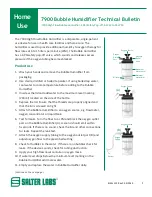
1-4
rEm
star
p
lus
m s
ErIEs
u
sEr
m
anual
1.3.2 C
autIons
A Caution indicates the possibility of damage to the device.
•
The device may only be operated at temperatures between 41° F (5° C) and 95° F (35° C).
• If this device has been exposed to either very hot or very cold temperatures, allow it to adjust
to room temperature before starting therapy. Condensation may damage the device.
• Do not immerse the device or allow any liquid to enter the enclosure or the inlet filter.
• A properly installed, undamaged reusable foam inlet filter is required for proper operation.
• Tobacco smoke may cause tar build-up within the device, which may result in the device
malfunctioning.
Note:
Additional warnings, cautions, and notes are located throughout this manual.
1.3.3 C
ontraIndICatIons
When assessing the relative risks and benefits of using this equipment, the clinician should
understand that this device can deliver pressures up to 20 cm H
2
O. In the event of certain fault
conditions, a maximum pressure of 30 cm H
2
O is possible. Studies have shown that the following
pre-existing conditions may contraindicate the use of CPAP therapy for some patients:
• Bullous Lung Disease
• Pathologically Low Blood Pressure
• Bypassed Upper Airway
• Pneumothorax
• Pneumocephalus has been reported in a patient using nasal Continuous Positive Airway
Pressure. Caution should be used when prescribing CPAP for susceptible patients such as
those with: cerebral spinal fluid (CSF) leaks, abnormalities of the cribriform plate, prior
history of head trauma, and/or pneumocephalus. (Chest 1989; 96:1425-1426)
The use of positive airway pressure therapy may be temporarily contraindicated if you exhibit
signs of a sinus or middle ear infection. Not for use with patients whose upper airways are
bypassed. Contact your physician if you have any questions concerning your therapy.









































